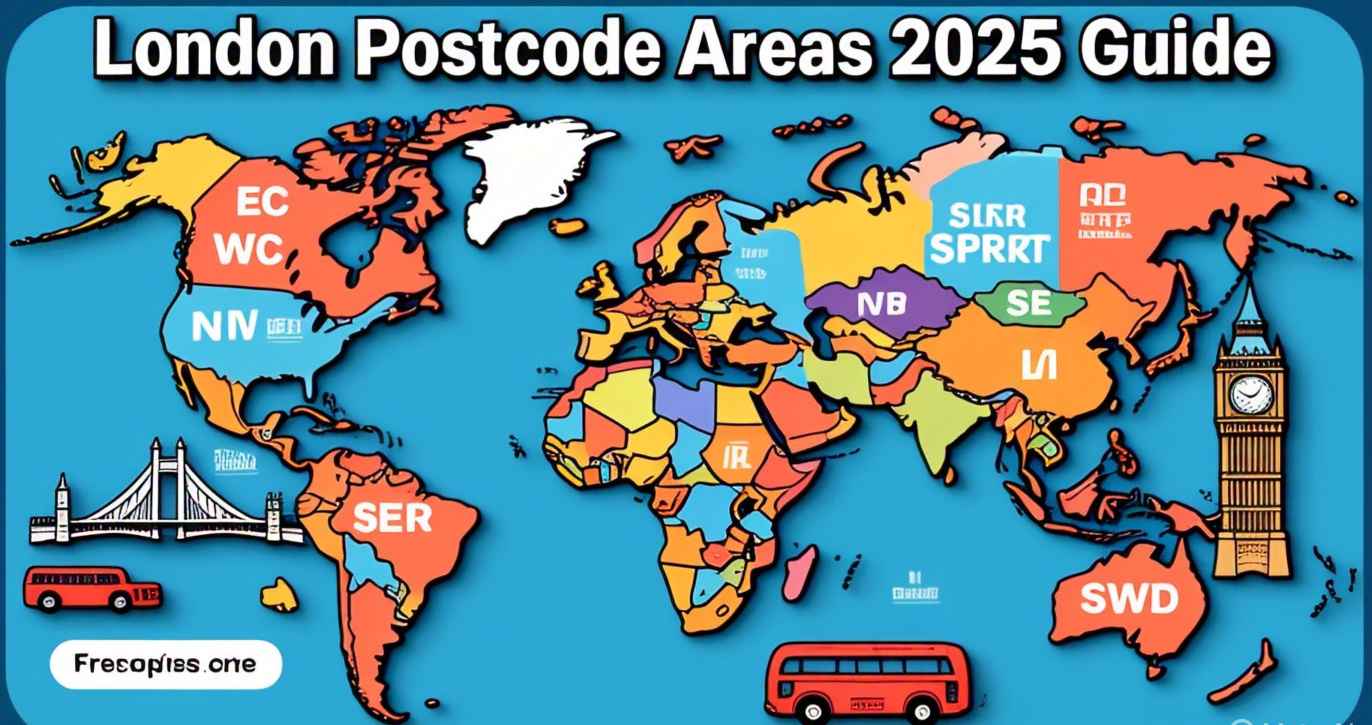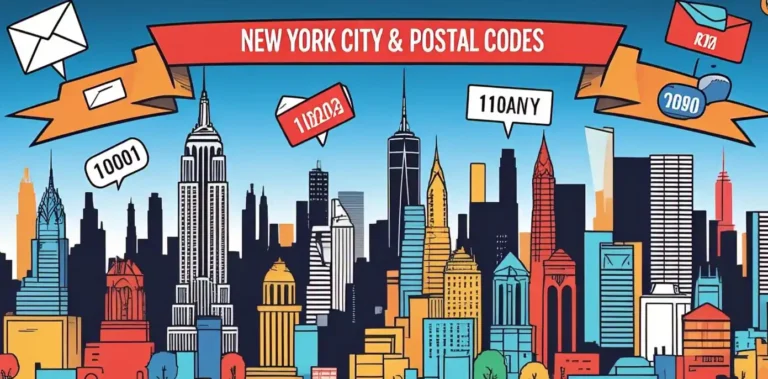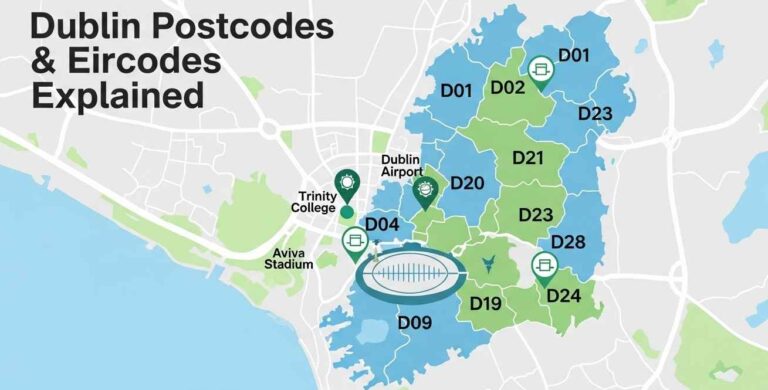Complete Guide to London Postal Codes and Zip Codes in 2025
Postal Codes and Zip Codes for London UK are alphanumeric codes used to identify specific streets and areas in London.
They help route mail accurately by showing both the broader location and the exact address within the city.
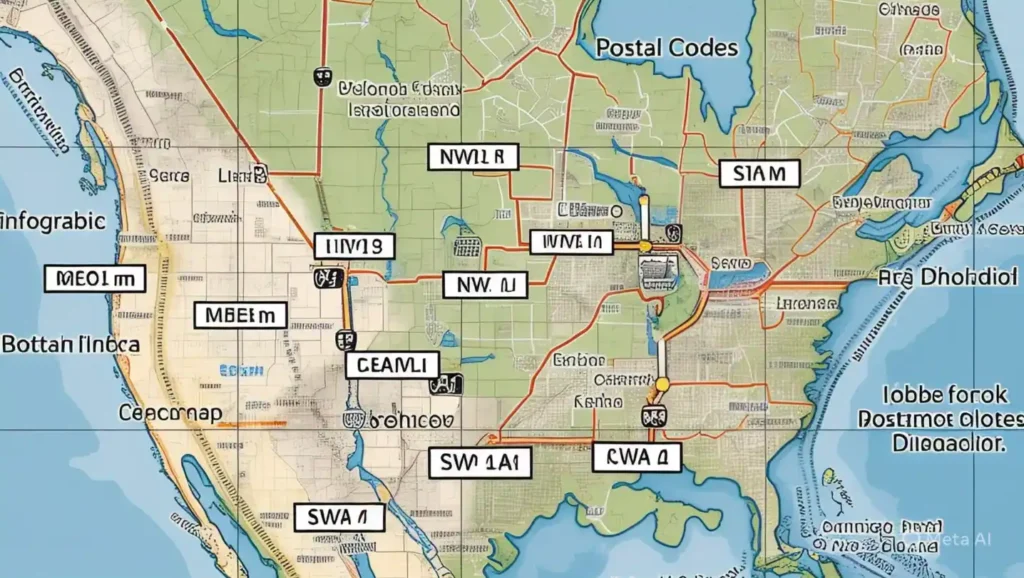
It helps organize mail delivery across the city.
Each postcode includes two parts — the outward code, which shows the geographic area, and the inward code, which points to the specific street or location.
These codes are alphanumeric, meaning they use both letters and numbers.
For example, WC1 refers to the City of London, EC1 means East Central, SW is for South West, and NW stands for North West.
If you live in Orpington, your postcode might be BR6, and a full example like BR6 0BY would show your street on Dalewood Road.
Postcodes in London usually cover one street or half of it, depending on the coverage area.
The right formatting is important, as it helps mail reach the correct address.
These codes apply across different areas, locations, and cities, and are a key element of the UK’s postal system.
Difference Between Zip Code and Postal Code
A zip code is mainly used in the United States and the Philippines, while a postal code is used in other countries like Canada, the UK, and Australia.
Both serve the same purpose—to help identify locations for mail delivery—but they differ in terminology and regional usage.
Difference Between Zip Code and Postal Code lies in the name and the countries where each is used.
A zip code is a type of postal code used mainly in the USA and the Philippines.
The term ZIP Code stands for Zone Improvement Plan, and it was created to make mail delivery faster and more efficient in the United States.
On the other hand, a postal code is the more general term used in most other countries, such as Canada, Germany, Ireland, Australia, and the United Kingdom, where it may also be called a postcode.
These codes serve the same purpose—to identify a specific area or location for mail and package delivery.
Though the terminology varies, both zip codes and postal codes are essential for sorting and delivering mail throughout the world.
They are part of each country’s unique system but function similarly to ensure efficient postal services.
London Postal Codes List (2025 Updated)
All London Postal Code Areas (2025 Updated) offers a complete view of how London is organized for efficient mail handling.
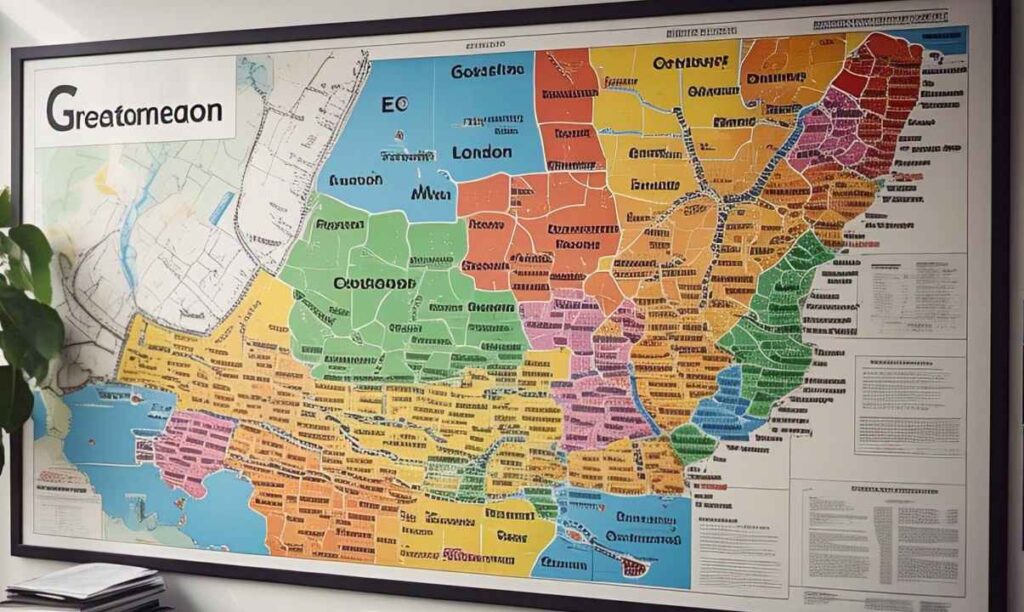
With 180,488 unique postcodes, Greater London is carefully divided into clear geographic areas, further split into smaller areas down to the street-level.
These postal codes are essential. They help mail delivery services quickly locate any address.
Whether you’re sending a letter or expecting a parcel, the correct postcode ensures it reaches the right place without delays.
This system makes everyday mail movement across London smooth and reliable.
Central London Postcodes
Central London is divided into two main postcode areas: East Central (EC) and West Central (WC).
- East Central (EC) postcodes include:
- EC2Y — covers the Barbican area.
- EC2A — covers the Shoreditch area.
- West Central (WC) postcodes include:
- WC1B — covers areas like the British Museum and Bloomsbury.
- WC2E — covers the famous Covent Garden area.
- Each postcode has two parts:
- The first part (e.g., WC2E) shows the general geographic area.
- The second part narrows the location down to street-level detail.
For example, WC2E 7HQ points to Southampton Street in Covent Garden, London, England.
This clear postcode system makes it easy to locate specific areas and streets within Central London.
North London Postcodes include areas like Islington, Camden, Haringey, and Enfield, covered by postcode districts starting with “N” and “NW”. The region contains 38 postcode districts such as N1 (Islington), N4 (Finsbury Park), and NW3 (Hampstead), forming part of the London N postcode area.
North London Postcodes
North London Postcodes are postal code areas that help identify specific regions in North London.
These include both N (Northern) and NW (North Western) postcode areas. Together, they cover popular districts like:
- N1 – Islington
- N4 – Finsbury Park
- N6 – Highgate
- NW1 – Camden Town
- NW3 – Hampstead
The N postcode area includes 22 postcode districts, while the NW area has 12. In total, North London has 38 postcode districts and over 31,000 live postcodes.
Why They Matter?
Postcodes are more than numbers. They help with:
- Finding addresses easily
- Sorting and delivering mail quickly
- Identifying local services and council areas
Whether you’re looking for a place to live or send mail, knowing the postcode can make things much easier.
Examples of North London Postcodes
| Postcode | Area |
|---|---|
| N1 | Islington |
| N2 | East Finchley |
| N5 | Highbury |
| NW5 | Kentish Town |
| NW11 | Golders Green |
You can also break a postcode into two parts: the first half (e.g., N1) shows the broader area, and the second part (e.g., N1 2RY) points to the exact location like Gaskin Street in Islington.
Postcodes = Place Identity
From Stoke Newington (N16) to Cricklewood (NW2), each postcode shapes part of London’s identity.
These codes help keep the city organized, easy to explore, and rich with history.
East London Postcodes
East London Postcodes include areas like Whitechapel, Shoreditch, Hackney, Clapton, and Walthamstow, with postcode districts such as E1, E2, E3, E5, E8, E15, and E17.
These postcodes fall under the E postcode area of London, covering diverse and vibrant neighborhoods in the eastern part of the city.
Discovering East London Postcodes
The E postcode area of London, also known as East London, is rich in culture, history, and modern development.
From the creative vibe of Shoreditch (E1) to the residential calm of Walthamstow (E17), each postcode has something unique to offer.
Key East London Postcodes and Areas
- E1: Covers Whitechapel and Shoreditch
- E2: Includes Bethnal Green
- E3: Covers Bow
- E5: Covers Clapton
- E8: Known for Hackney and Arcola Street (E8 2DJ)
- E15: Includes Stratford
- E17: Covers Walthamstow
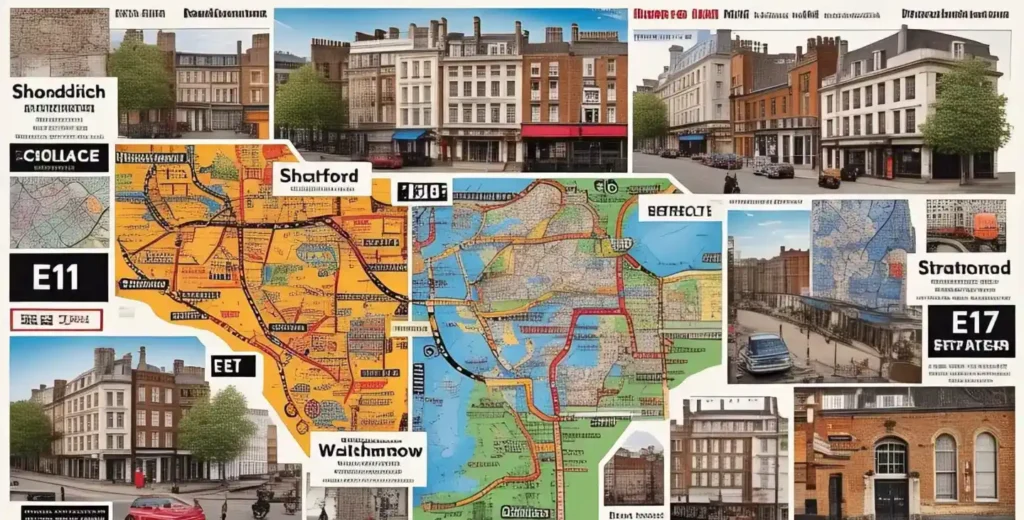
Boroughs and Coverage
The East London postcode area spans several London boroughs:
- Hackney
- Newham
- Tower Hamlets
- Islington
- Redbridge
- Waltham Forest
- Sewardstone
- City of London and County of the City of London
Quick Facts
- E postcodes are part of the UK postcode system.
- The area contains over 370,000 households.
- The 2011 census reported a population of around 989,043.
Whether you’re moving to East London, sending mail, or exploring the city, knowing these postcodes helps you navigate and connect with each area easily.
South East London Postcodes
South East London Postcodes include areas such as Greenwich (SE10), Peckham (SE15), Woolwich (SE18), Dulwich (SE21), and Forest Hill (SE23), covering key locations in the south and south-east parts of London, England.
The South East London Postcodes fall under the SE (South Eastern) postcode area.
This region includes several popular districts and boroughs known for their culture, history, and local life.
Key Postcodes and Their Areas
- SE10 – Greenwich
- SE15 – Peckham
- SE18 – Woolwich
- SE21 – Dulwich
- SE23 – Forest Hill
Each postcode helps identify a specific area. For example, SE15 4PE is a full postcode for Costa Street in Peckham.
Coverage and Boroughs
The SE postcode area stretches across the south and south-east of London, covering areas from Albert Embankment to West Heath, and reaching near Sidcup and Selhurst.
It loosely includes or borders parts of these boroughs:
- Greenwich
- Southwark
- Lewisham
- Croydon (north)
- Lambeth (east)
- Bexley (west)
- Bromley (northwest)
This makes the SE post town one of the most diverse and connected in London, ideal for anyone exploring the heart of South East London.
South West London Postcodes

South West London Postcodes cover a wide range of vibrant districts in London, including areas like Westminster, Clapham, Chelsea, Wimbledon, and Battersea, with postcode districts ranging from SW1 to SW20.
South West London Postcodes include some of the most well-known and diverse areas of London, England.
These postcode districts help organize the city by street-level detail and are part of the London post town system.
This region is divided into two key subdivisions: the South Western and the Battersea operational district.
Key Areas and Their Postcodes
- SW1: Covers Westminster, and its smaller codes include SW1A, SW1E, SW1H, SW1P, SW1V, SW1W, SW1X, and SW1Y
- SW2: Brixton
- SW3: Chelsea, including Sloane Avenue
- SW4: Clapham
- SW5: Earls Court
- SW6: Fulham, Parsons Green
- SW7: South Kensington
- SW11: Battersea
- SW16: Streatham
- SW19: Wimbledon
These postcode districts span areas with rich culture, green spaces, and excellent transport. From stylish Knightsbridge to relaxed Balham and Stockwell, each district offers something unique.
Highlights
- Chelsea district, Clapham district, Fulham district, and Earls Court district form the heart of the South West London Postcodes.
- This group of 20 postcode areas lies on both sides of the River Thames.
- The system provides clear coverage and makes navigation and identification easier across this part of London.
Whether you’re exploring Brompton, living in Wimbledon, or commuting from Clapham, the postcode structure of South West London supports everyday life with clarity and order.
West London Postcodes
West London Postcodes cover key areas like Paddington, Acton, Chiswick, Kensington, and Notting Hill.
Each postcode, such as W1C for Oxford Street or W11 for Notting Hill, helps identify specific geographic locations down to the street level, making navigation across West London easy and precise.
West London Postcodes include well-known areas such as Paddington, Acton, Chiswick, Kensington, Notting Hill, and more.
These postcodes begin with a ‘W’ followed by numbers and letters that pinpoint exact locations. For example:
- W1C covers Oxford Street,
- W1B is for Regent Street,
- W2 relates to Paddington,
- W3 is Acton,
- W4 is Chiswick,
- W5 is Ealing,
- W6 is Hammersmith,
- W8 is Kensington,
- W11 is Notting Hill,
- W12 is Sheperd’s Bush.
Postcodes can get more specific with a second part, like W11 2ND, which narrows down to street-level locations such as Stanley Gardens in Notting Hill.
These codes are important for geographic clarity, helping people and services find exact areas in West London within England.
Using West London Postcodes makes travel, mail delivery, and location finding simple and efficient.
Each postcode defines a clear area, ensuring easy navigation throughout this vibrant part of London.
North West London Postcodes
North West London Postcodes include areas like Camden, Hampstead, Kentish Town, St. John’s Wood, Kilburn, and Cricklewood.
These postcodes fall under the NW (North Western) area of London and cover key postcode districts such as NW1, NW2, NW3, NW5, NW6, NW8, NW9, NW10, and NW11.
North West London Postcodes are part of the NW postal district, which was originally created in 1856 as a sector of the London postal system.
Today, this area includes 13,895 live postcodes, making it a large and active postal region.
Key Areas and Postcodes:
- NW1 – Camden, Regent’s Park, Euston
- NW2 – Cricklewood
- NW3 – Hampstead
- NW5 – Kentish Town
- NW6 – Kilburn
- NW8 – St. John’s Wood
- NW9–NW11 – Cover parts of Westminster, Barnet, Brent, Harrow, Ealing, Hammersmith, Fulham, Kensington, and Chelsea
Each postcode is broken into a street-level format (e.g. NW1 8BF) to pinpoint geographic areas accurately. Places like Hawley Mews in Camden are examples of this detailed level.
These postcode districts are managed under various local authority areas, supporting strong infrastructure and community development.
Being part of North West London means access to historical areas, green parks, and excellent transport links—all of which contribute to its ongoing popularity.
London Postal Code 6 Digit
London postal code 6 digit format does not exist. Instead, London uses an alphanumeric postcode system typically made up of 5 to 7 characters, divided into two parts: the outward code and the inward code
London postal codes do not follow a 6-digit numeric format.
Like the rest of the United Kingdom, London uses a structured alphanumeric postcode system, which includes both letters and numbers.
This format ensures precise and efficient mail sorting and delivery across the city.
Structure of a London Postcode
A full London postcode typically contains 5 to 7 characters, divided into two key parts:
- Outward Code:
- Appears before the space
- Identifies the postcode area and district (e.g., N6, SW1W, E12)
- Can range from two to four characters
- Inward Code:
- Follows the space
- Helps locate a specific street or group of addresses
- Usually consists of one digit and two letters (e.g., 4AL, 0NY)
Real Examples
Examples of actual London postcodes include:
- SW1W 0NY
- N6 4AL
These postcodes are highly localized, making it easy to identify even small areas within districts.
This professional postcode format helps businesses, postal services, and residents by offering precise location identification and faster delivery throughout the city.
London Zip Codes
London zip codes are known as postcodes in the UK and follow an alphanumeric format like “SW1A 1AA”.
These codes identify specific areas and districts across inner and outer London for accurate addressing and navigation.
London zip codes are officially called postcodes in the United Kingdom.
Instead of a numeric zip code system like in the US, London uses an alphanumeric postcode system that combines letters and numbers, typically 5 to 7 characters long.
Each postcode is split into two parts: the outward code (e.g., SW1) which identifies the area and district, and the inward code (e.g., 1AA) which pinpoints a more specific location within that district. A full example is SW1A 1AA.
Inner London areas use postcode prefixes like E, EC, N, NW, SE, SW, W, and WC. Outer London includes codes like BR, CR, and CM.
These help in distinguishing between central and suburban zones across Greater London.
To find any postcode in London, the Royal Mail postcode finder tool is a reliable source. It’s commonly used for addressing, deliveries, and location-based services.
5 Digit Zip Code London
5 Digit Zip Code London does not exist, as the UK uses an alphanumeric postcode system instead of numerical 5-digit zip codes.
London postcodes are structured with letters and numbers that identify specific areas and delivery points.
5 Digit Zip Code London is a common search term, especially among visitors familiar with US addressing formats.
However, in the United Kingdom—including London—zip codes are not used. Instead, the UK operates under a detailed postcode system that is more precise and alphanumeric in structure.
Key Differences from US Zip Codes:
- No 5-digit codes: London does not use a simple numeric format like 90210.
- Postcodes include letters and numbers, such as SW1A 0AA or E14 3BE.
- The structure breaks down into:
- Outward code (e.g., SW1): Indicates the broader geographic area.
- Inward code (e.g., 0AA): Points to a specific street or building.
Examples of London Postcodes:
- N1 9RN – North London (Islington area)
- SW1A 0AA – Westminster, central government district
- E14 3BE – Canary Wharf, East London
Common Postcode Areas in London:
- N – North
- NW – North West
- E – East
- SE – South East
- SW – South West
- W – West
- EC – East Central
- WC – West Central
This system ensures accurate mail delivery and provides detailed location reference far beyond a simple zip code.
Understanding this format is essential for navigating London addresses efficiently.
Central London zip code
Central London zip code is not a single code but a combination of postcode districts like EC (East Central), WC (West Central), and parts of W1. Each district covers specific areas and buildings within central London.
Central London zip code refers to a group of alphanumeric postcode districts rather than one unified code. London’s postal system is detailed and structured to reflect the city’s layout and administrative zones.
Key Districts in Central London:
- EC (East Central) – Covers areas like the City of London and Shoreditch. Common postcode examples: EC2Y, EC2A, EC3.
- WC (West Central) – Includes landmarks such as the British Museum, Bloomsbury, and Covent Garden. Common codes: WC1B, WC2E.
- W1 Area – Also regarded as part of Central London, including well-known areas like Mayfair and Soho, with codes like W1A, W1B.
Each postcode includes two elements:
- Outward code – Identifies the broader area (e.g., WC2E)
- Inward code – Pinpoints the specific building or street (e.g., WC2E 7HQ)
How to Find the Correct Code:
To identify the specific postcode within Central London:
- Know the exact street name or building.
- Use a postcode finder tool or refer to official address records.
This postcode structure helps with accurate mail delivery, location navigation, and service zoning within the heart of London.
West London Zip code
West London zip code areas use the “W” postcode prefix, covering districts from W1 to W14.
These codes represent neighborhoods like Kensington, Ealing, Hammersmith, and Notting Hill, making navigation and mail delivery in West London efficient and organized.
West London zip code areas are designated with the “W” prefix, which stands for West London in the UK postcode system.
These alphanumeric codes range from W1 to W14 and help identify specific districts and neighborhoods across the western part of London.
Key Features of West London Zip Codes
- W1: Covers the heart of central London, including exclusive areas like Portland Place and Regent Street. This district is further divided into sub-districts like W1A and W1B for even more precision.
- W2 to W14: Spread across West London, these codes identify popular residential and commercial zones.
Examples of W Postcode Districts
- W2 – Paddington, Bayswater
- W3 – Acton
- W4 – Chiswick
- W5, W13 – Ealing and West Ealing
- W6 – Hammersmith
- W7 – Hanwell
- W8, W14 – Kensington and Brook Green
- W9 – Maida Vale and Warwick Avenue
- W10 – North Kensington, Queens Park
- W11 – Notting Hill, Holland Park
- W12 – Shepherd’s Bush
These postcode districts span across several boroughs such as Westminster, Kensington and Chelsea, Ealing, and Hounslow. Each zip code helps define specific geographic areas, making it easier for postal services, deliveries, and travelers to locate destinations.
Why West London Zip Codes Matter
- Organized Addressing: Enhances accuracy in mail and package delivery.
- Geographical Clarity: Makes identifying neighborhoods and planning travel routes easier.
- Local Identity: Each code represents a distinct character, culture, and lifestyle in London.
West London zip codes are a smart and efficient way to navigate one of the most vibrant and diverse regions of the UK capital.
How to Send a Mail to London?
To send a mail to London, first ask your friends or family for their full address, including postcodes. This is the easiest and most accurate way.
If you don’t have it, you can use the Royal Mail postcode finder to figure it out.
Once the address is ready, write it clearly on the envelope.
Make sure to put the correct postage. After that, you’re ready for sending — simply drop your letter into a postbox or take it to the post office.
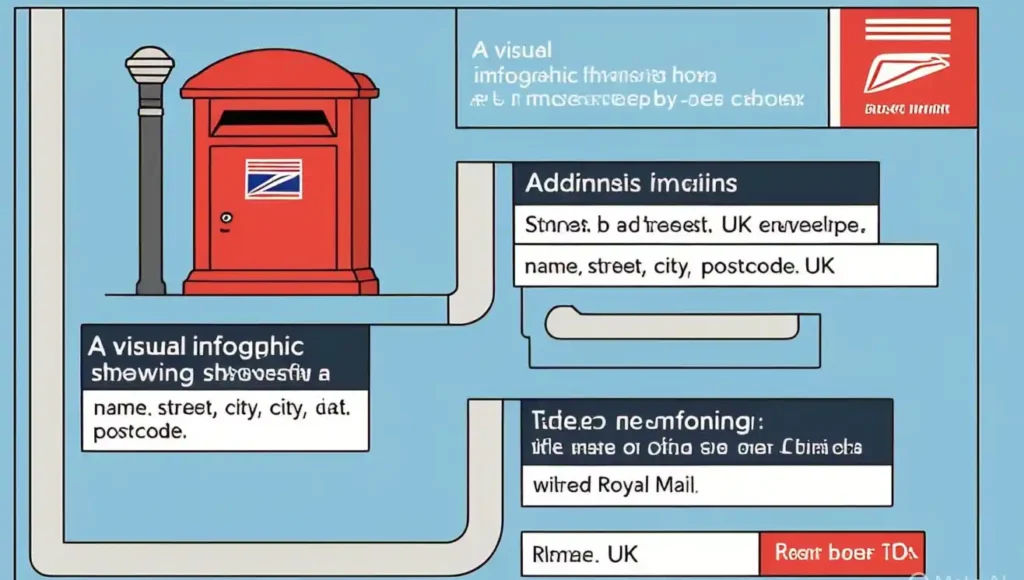
How to Address a Letter to England
To address a letter to England correctly, start with the full name of the person or company receiving the letter.
On the next line, write the house number followed by the street name.
Then, add the city, such as London. After that, include the postal code, which helps the mail get to the right area quickly.
Finally, write the country as UK to complete the address.
This clear and valid format ensures your letter reaches the recipient without any delay.
Following this simple structure is the best way to send mail to England or anywhere in the UK.
Conclusion
London postal codes are a reliable way to find exact addresses and ensure fast mail delivery.
They are easy to understand and help both locals and visitors explore the city smoothly.
London has a smart postal code system that uses alphanumeric codes to mark specific streets and areas.
Each code has two parts: the outward code shows the geographic zone (like north or west), and the inward code points to the exact location.
This formatting makes mail delivery smooth and helps with easy navigation.
Whether you’re living in London or planning to send mail to someone, knowing the right postcode is very important.
It’s best to ask the person directly for their code to avoid mistakes.
These postcodes are usually made of 5 to 7 digits, and they include both letters and numbers.
The difference between postal and zip codes is only in the terms used.
Zip codes are used in the USA and Philippines, while postal codes are used in the UK, Ireland, Canada, and Australia.
No matter what they are called, they all serve the same purpose — helping people reach the correct address with ease.
Frequently Asked Questions
What is London’s postal code?
London’s postal code system uses alphanumeric codes like SW1A 1AA. These codes help mail reach the right place. Each code shows the area and street or building.
What is the postal code for the city of London?
The City of London uses postcodes like EC1, EC2, and EC3. These are part of the East Central area. Each code helps deliver mail to the correct street.
What is a valid UK postcode?
A valid UK postcode looks like SW1A 0AA or E14 3BE. It has two parts: the outward code for the area and the inward code for the street or building. It uses both letters and numbers.
Are all UK postcodes 7 digits?
Not all UK postcodes are 7 digits. They can be 5, 6, or 7 characters long. The code always has two parts: one for the area and one for the street.
What is a 5-digit Zip Code in the UK?
The UK does not use 5-digit zip codes like the USA. Instead, it uses postal codes that mix letters and numbers. These postal codes help show exact areas and streets for mail delivery.
What is the UK zip code?
The UK does not use the term “zip code.” Instead, it uses postcodes like N1 9GU or W1A 1AA. These help mail reach the correct address quickly.
What is a valid Zip Code in the UK?
A valid UK postal code has letters and numbers. It has two parts: the outward code for the area and the inward code for the street. For example, WC1A 1AA is a valid London postcode.
How do you write a Zip code in London?
Write the postcode in two parts with a space, like “SW1A 1AA.” The first part shows the area, and the second part points to the exact street or building.
What is the postcode for London?
London has many postcodes like EC, WC, N, NW, SE, SW, and W. Each covers different parts of the city. For example, EC1 covers East Central London, and SW1 covers South West London.
How do you write the postcode for London?
Write the postcode after the city name with a space in the middle, like “London SW1A 1AA.” The format is important to help mail reach the right place.
How do I send a mail from the USA to UK?
Write the full address with the name, house number, street, city (London), postcode, and country (UK). Use the correct postage and drop the mail in the postbox or take it to the post office.
Are postal codes reused?
Postal codes are unique to each street or area. They help delivery be fast and clear, so codes are not reused for different places.
Do postal codes determine council tax?
Postal codes help identify areas but do not directly decide council tax. They help local councils know which properties belong in their area.
Can two places share the same postcode?
A postcode usually covers one street or part of a street. Sometimes small areas share the same postcode if they are very close.
Why are there gaps or missing codes?
Some codes are missing because they were never used or kept for future needs. This helps the postal system stay organized.
How often are postcode boundaries updated?
Postcode boundaries are updated as needed to reflect changes in buildings, streets, or new areas. This keeps mail delivery accurate and efficient.
Disclaimer
This content is provided by traveldrizzle.com for general information only. We do not guarantee accuracy and advise verifying postal codes through official sources.
